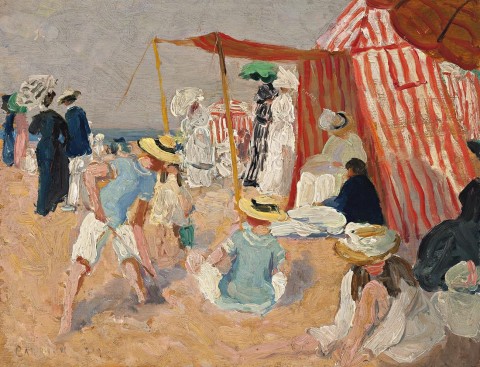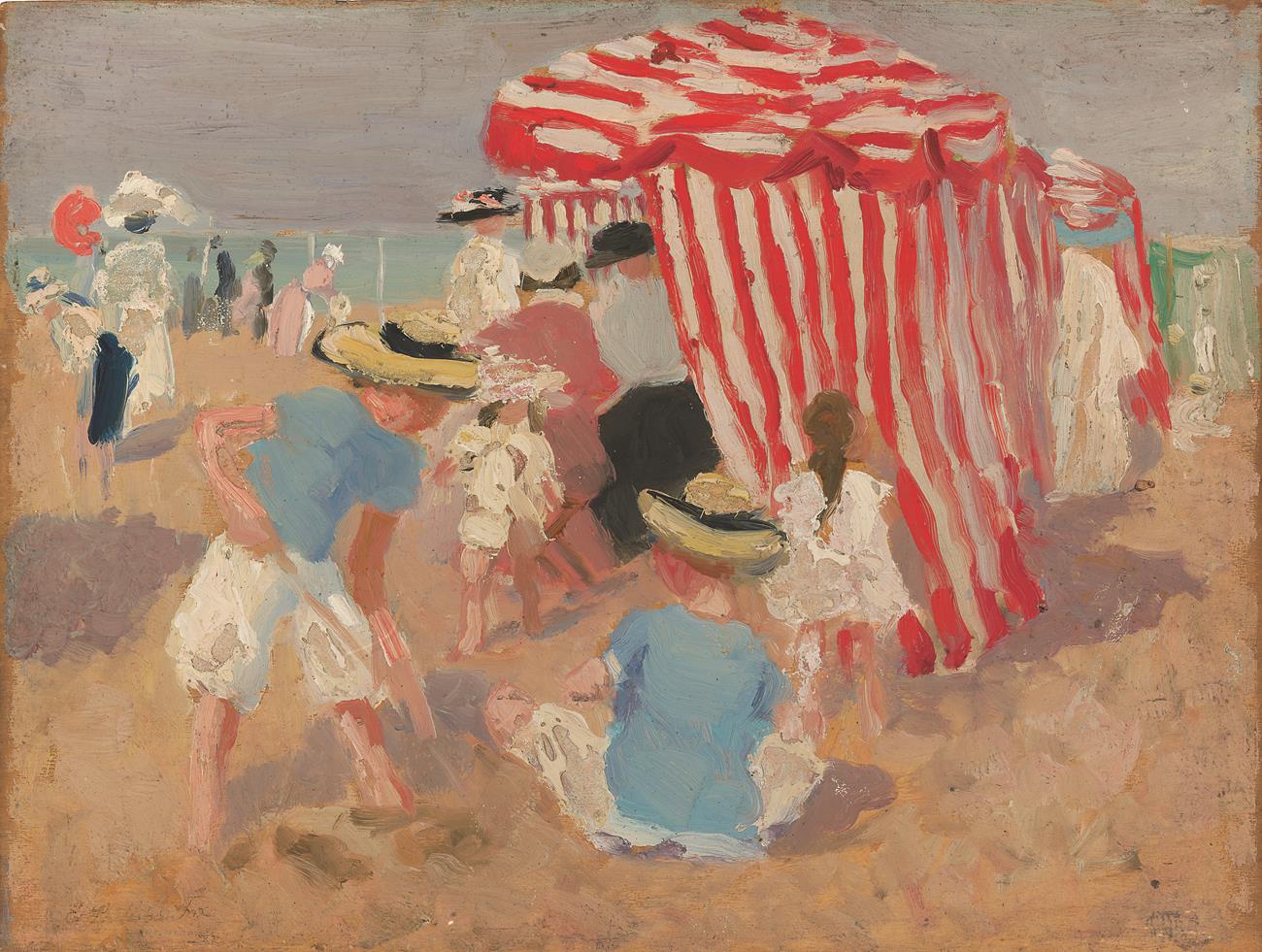SUR LA PLAGE, 1910
ETHEL CARRICK FOX
oil on wood panel
27.0 x 35.0 cm
signed and dated lower left: CARRICK 1910
bears inscription verso: Né [sic] en Australie / Membre des Artistes Français / a obtenu la medaille de 3e classe / en 1894
bears inscription on label verso: 10 / Sur la plage / Ethel Carrick / 65 Bd. Arago
Private collection, USA
Christie’s, London, 14 December 2017, lot 2
Private collection, Sydney
Beach Scene, c.1909, oil on canvas mounted on cardboard, 38.0 x 55.4 cm, in the collection of the National Gallery of Australia, Canberra
Emanuel Phillips Fox, (On the Sand), c.1910, oil on wood panel, 26.7 x 35.1 cm, in the collection of the National Gallery of Australia, Canberra, Illus. in Eagle, M., The Oil Paintings of E. Phillips Fox in the National Gallery of Australia, National Gallery of Australia, Canberra, 1997, p. 51
When Ethel Carrick Fox held her solo exhibition in Sydney in July of 1913, the critic for the Sydney Morning Herald wrote: ‘The first characteristic observed on meeting [her] is a certain joyous vivacity, an air of pouncing upon the matter in hand and bearing it at once into a prominence of light and colour. The same qualities are reflected in her work. Painting after painting display an almost child-like love for light, movement, the interplay of brilliant hues’.1 The artist is her art, an enthusiast for beauty. In Sur la Plage, 1910 the visual excitement created by the deft handling of paint – touched, drawn, or shaped into an image – witnesses the marriage of light and colour. The spontaneous, almost impetuous brush strokes respond directly to the motif with all the freedom provided by painting out-of-doors. Add the elegance and fashion of La Belle Époque and you have a masterpiece, intimate in scale and moment, sunny in mood. Emanuel Phillips Fox’s (On the Sand), c.1910, in the collection of the National Gallery of Australia, Canberra, provides a companion view. Settings, figures, attire and poses show that they were painted together, probably at Royan, variations being the different responses of two highly individual artists. The Foxes often spent their summers painting at the fashionable French beach resorts – Trouville, Deauville, Dinard and Royan, where their friend, Rupert Bunny, had painted two years previous.
Middlesex born and London bred, Ethel Carrick had married Emanuel Phillips Fox in London in 1905 before moving to Paris with him to live near Jeanne and Rupert Bunny. (Their address of 65 Boulevard Arago, Paris is recorded on the label on the verso of our painting.) With a Slade School background, Ethel had embraced plein-air painting at the Newlyn artists’ colony, Cornwall, before graduating to the more avant-garde colony of St Ives, where she met Fox. In France, the Foxes painted in the Luxembourg Gardens and the fashionable beachside resorts, Emanuel and Rupert having a pleasing influence on each other’s work. Beginning with Eugène Boudin and Claude Monet at Trouville, paintings of beaches came into prominence in France in the latter part of the nineteenth century. Carrick and Fox painted there in 1909. Two fine examples, Carrick’s Beach Scene, c.1909 and Fox’s Promenade, c.1909, are in the collection of the National Gallery of Australia. Sur la Plage recalls Monet’s breezy The Beach at Trouville, 1870 (National Gallery, London) in its handling of light and presentation of figures, sun shaded and seated on the beach. The differences are Carrick’s colour-loaded palette and lively brushwork, showing the impact of Henri Matisse and fellow-exhibitors at the Salon d’Automne, of which she became a sociétaire in 1911. As in many of her beachside paintings, in Sur la Plage the red-and-white striped tents on golden sands, anchored by deep blacks, capture the eye and set up a vibrancy that echoes throughout the composition. Here, the engaging expression of belle époque elegance and pleasure in idle moments, entwines leisure and beauty within the sensuous play of light, texture and colour.
1. ‘Impressionism’, Sydney Morning Herald, Sydney, 7 November 1913, p. 7
DAVID THOMAS

